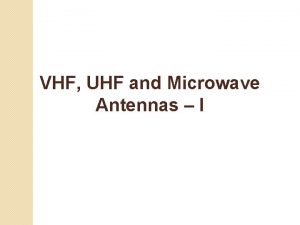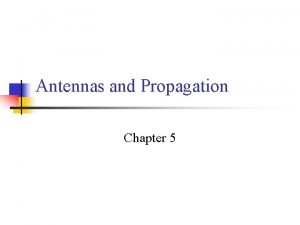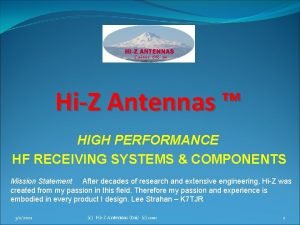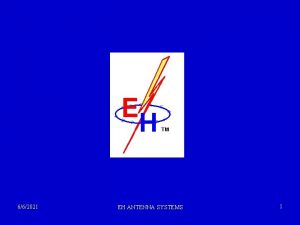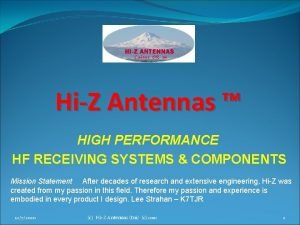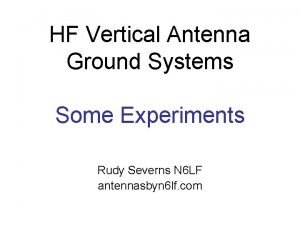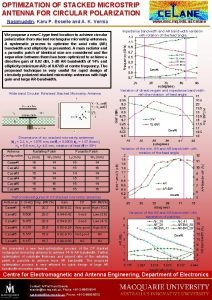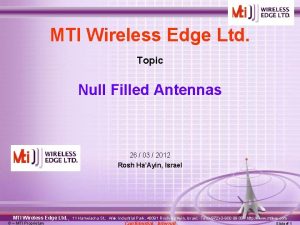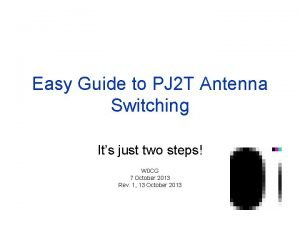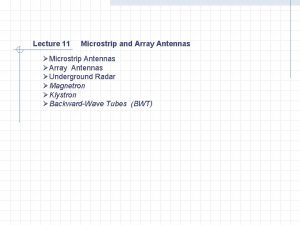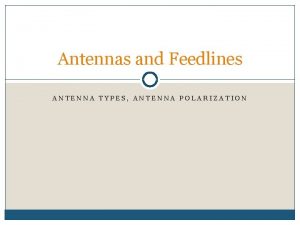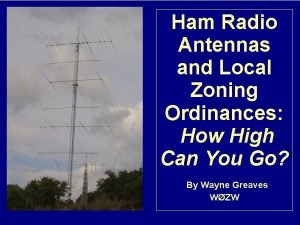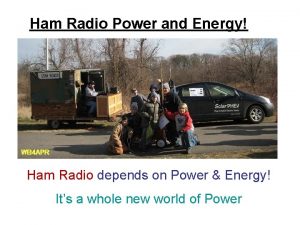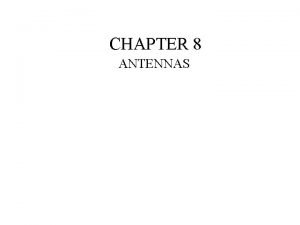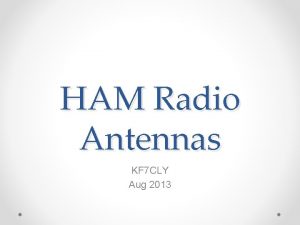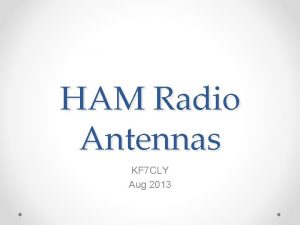HAM ANTENNAS A PRACTICAL INTRODUCTION TO THEORY AND













- Slides: 13

HAM ANTENNAS: A PRACTICAL INTRODUCTION TO THEORY AND OPERATION OF ANTENNAS BY K 0 YY

ANTENNA PRESENTATION OUTLINE • Basic Antenna Theory/Terms • Antenna Specifications • Types of Antennas • References • Summary

ANTENNA REFLECTED POWER/SWR • Antenna Fact: Antennas must radiate the transmitters power to be effective. Any power reflected back towards the transmitter is lost and may damage the transmitter. • Standing Wave Ratio (SWR): SWR is a measure of impedance matching of an antenna to the characteristic impedance of a transmission line. The perfect impedance match is 1: 1 or for example 50 ohm to 50 ohm. Operationally up to 2: 1 or even slightly higher is acceptable for short periods. • SWR is a measurement of how effective the antenna is radiating power on a given frequency. SWR increases as the transmitter is tuned

ANTENNA BASIC THEORY/TERMS • Feed Point Impedance/AKA Radiation Resistance– Varies by type of antenna, typically “matched” to 50 Ohm impedance to use 50 Ohm feed line to match the 50 ohm output of radios. • Resonant Frequency— Each antenna has a “resonant” point based upon length/element diameter– It is where the most power is radiated. Resonance basically is the point where the SWR is minimum. Half Wave Dipole Formula: Length in feet = 468/F (MHz). Example: 40 meter dipole = 468/7. 250 = 64. 55 or 64 feet 7 inches total length. Therefore each side of the dipole =

• Antenna Bandwidth– Is the frequency coverage of an antenna where the reflected power/Standing Wave Ratio (SWR) is below the lower and upper 2 to 1 points on an SWR curve.

• Take Off Angle– The main lobe of radiation above the horizontal plane measured at a specified height above ground. Dipole = ~30 degrees, Vertical = ~10 degrees. Horizontal Yagi = ~30 degrees. • Beam Width– The actual ½ power path of radiation from a beam style antenna, varying based upon the number of elements. Example 3 -element Yagi = ~35 degrees wide

ANTENNA SPECIFICATIONS Antenna Gain is Specified in decibels (d. B). See also next chart. • d. Bi = Decibel gain compared to an Isotropic (point) theoretical source. • d. Bd = Decibel gain compared to a Dipole • Antenna Fact: Every 3 d. B of antenna gain doubles the Effective Radiated Power (ERP) of an antenna. • ERP Power is a real power gain, (focused in the forward direction for a beam style antenna, and towards the horizon in a vertical colinear type antenna).

ANTENNA TRUTH TABLE-- BILL ORR HANDBOOK

TYPICAL TYPES OF ANTENNAS VHF/UHF ANTENNAS-- See examples on the tables • Verticals– • Ground Plane– Typically ¼ wave or 5/8 wave size element • Colinear-- multi-element In-line, for added gain • Multi-element • Yagis • Quads • Quagis FM versus SSB Polarization-- FM = Vertical, SSB =

TYPES OF VHF/UHF ANTENNAS MOBILE ANTENNAS • Verticals/Whips— Single/Multi-band -- Ground Plane versus Colinear (In-line for added gain) • Quad Loops– Typically horizontal loops used for 2 & 6 meters BASE STATION ANTENNAS • Verticals-- Single/Multi-band, Ground Plane versus Colinear • Dipole • Yagi Beam • Quad Loop FM VERSUS SSB • Polarization– FM = Vertical, SSB = Horizontal

TYPES OF HIGH FREQUENCY ANTENNAS MOBILE ANTENNAS • Verticals/Whips— Single band– center coils, helical wound • Multi-band– tapped, screwdriver BASE STATION ANTENNAS • Verticals– single or multi-band • Long-Wire (non-resonant and requiring a tuner or matching circuit) • Dipole- single or multi-band • Yagi Beam-single or multi-band, Tri-banders popular, • Delta or Quad Loop, Quad formula = 1005/ f (MHz) = length in feet 40 meter Delta loop = 1005/7. 250 MHz = 138 feet 6 inches

ANTENNA REFERENCES • ARRL Antenna Handbook • e. Ham website-- WWW. e. Ham. net/articles • Low Band (160 meters) DXing Book • ITS HF Propagation Software • CQ Magazine Articles • QST Magazine Articles • EZNEC Modeling Software-- https: //www. eznec. com/eznec. htm • Many Antenna Handbooks for various

SUMMARY • Basic Antenna Theory is not complex. Advanced theory is complex using physics principles and requires extra study. • Knowing basic antenna theory can help you select the proper antenna for what you want to accomplish. • Beam style antennas help you talk and hear further than standard verticals or dipoles. They focus power in the forward direction. • Colinear (stacked) antennas provide gain by focusing radiation towards the horizon (away from the vertical plane). • Understanding antenna characteristics such as resonance, bandwidth, and beam-width will help you in your operations.
 Vhf uhf and microwave antennas
Vhf uhf and microwave antennas Antennas and propagation
Antennas and propagation Hi-z antennas
Hi-z antennas Stacking yagi antennas
Stacking yagi antennas Eh antennas
Eh antennas Hi-z antennas
Hi-z antennas Hi-q antennas
Hi-q antennas Vertical
Vertical Nasimuddin+microstrip+antennas
Nasimuddin+microstrip+antennas (“mti wireless edge” or mtiwe) and anten
(“mti wireless edge” or mtiwe) and anten European school of antennas
European school of antennas Bencher skyhawk
Bencher skyhawk Broadband microstrip antennas
Broadband microstrip antennas Angelo kinicki management: a practical introduction
Angelo kinicki management: a practical introduction
